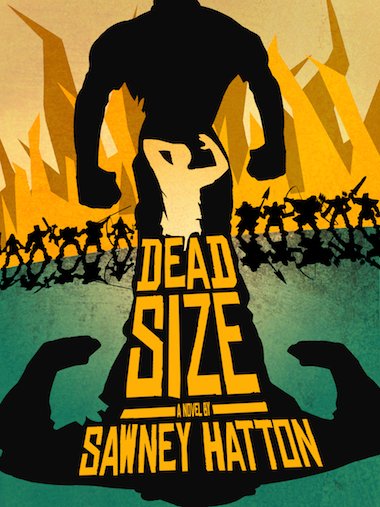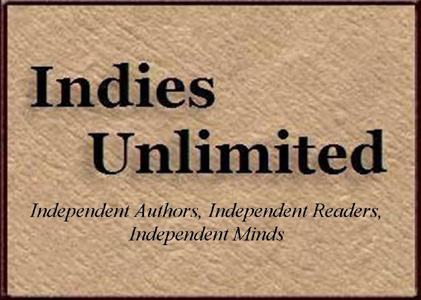Genre-wise, Dead Size is many things: a dark comedy, a psychological fantasy, a murder mystery, a police thriller, a love story. In a word, it’s different. There’s something for everybody… while perhaps not being for everybody.
Sawney Hatton
The Back Flap
Gulliver Huggens has issues. He watched his family perish in a tragic car accident as a child. He doesn’t know how to win the heart of the girl at the coffee shop. And he shares his home with a clan of mischievous tiny people.
Yet these all turn out to be the least of his troubles.
A secret race of Giants dwelling in the neighboring mountains wants Gulliver to exterminate all the Little People… or else. When folks in his hometown begin brutally dying, Gulliver must make a hard choice. But choices have consequences. And consequences, he’ll learn, come in all terrible sizes.
About the book
What is the book about?
My novel Dead Size is about a troubled young man who finds himself a pawn in a war between the clan of mischievous tiny people who live inside his house and a secret race of giants inhabiting the neighboring mountains.
Genre-wise, Dead Size is many things: a dark comedy, a psychological fantasy, a murder mystery, a police thriller, a love story. In a word, it’s different. There’s something for everybody… while perhaps not being for everybody.
When did you start writing the book?
Spring of 2008.
How long did it take you to write it?
Four years, which was at least two years longer than I had anticipated. I’d quickly discovered having a full-time job and being a perfectionist are not conducive to the most efficient writer’s work ethic.
Where did you get the idea from?
Great question. I honestly don’t remember. The idea may well have been implanted in my brain by E.T.s. This might also explain my profound dislike of space travel. Maximum 1 carry-on? What B.S.!
Were there any parts of the book where you struggled?
Only the parts between the beginning and the end. Did I mention I am a perfectionist?
What came easily?
Starting the book.
Are your characters entirely fictitious or have you borrowed from real world people you know?
They are fictitious, but like most authors, I’m sure all of my characters share some traits of the people I have known or met throughout my life… except Bogey Wiener. That bastard will never be commemorated in my work!
We all know how important it is for writers to read. Are there any particular authors that have influenced how you write and, if so, how have they influenced you?
I am influenced first and foremost by compelling storytelling. I was weaned on horror, particularly Stephen King and John Saul, and have since grown to appreciate satire (e.g., Christopher Moore, Jerzy Kosinki, and Torsten Krol) and thrillers (e.g., Robert McCammon, John Connolly, and Joe R. Lansdale), elements of each winding up in Dead Size.
Do you have a target reader?
Those who appreciate original storytelling. I don’t write cookie-cutter genre fare.
About Writing
Do you have a writing process? If so, can you please describe it?
I write whenever I have the time AND the mood strikes me. I never force myself. I won’t write crap just for the sake of writing; I’ve found that creates much more work for me later when I’m editing. Fortunately, I’m often in the mood to write.
Do you outline? If so, do you do so extensively or just chapter headings and a couple of sentences?
Dead Size was adapted from an original feature screenplay I had penned that was deemed by my agent too challenging to sell to producers. Using the screenplay as the book outline streamlined my writing a lot.
Even if I didn’t have a screenplay to adapt, I’d still map the whole story out in advance in as much detail as possible. Narrative problems are much easier to fix in the outline stage than they are when encountered 3/4 of the way into writing the novel, forcing you to rewrite god knows how much.
Do you edit as you go or wait until you’ve finished?
I tend to edit as I go so I don’t have to edit as extensively after I’ve completed the first draft. That said, it still took me almost a year to polish Dead Size enough where I felt it was publishable.
Did you hire a professional editor?
Yes. And I strongly encourage other self-published authors to do the same. You should treat your writing like a business. As such, you need to invest in your business, and hiring a professional editor ensures a level of quality control for your product (i.e., your book) that you would likely lack the objectivity to properly do yourself.
Do you listen to music while you write? If yes, what gets the fingers tapping?
No. Music distracts me when I’m writing. I will, however, listen to all varieties of music—from The Beatles to Captain Beefheart to Butthole Surfers—before I get to work or when I’m taking a break, to help inspire me or just to lubricate my brain.
About Publishing
Did you submit your work to Agents?
Yes. One agent. She passed.
What made you decide to go Indie, whether self-publishing or with an indie publisher? Was it a particular event or a gradual process?
I was attracted to the world of publishing almost as much as I was to writing. Marketing can be equally as creative, and the results equally as rewarding. Self-publishing also affords you control over how you want your book presented: you choose the cover art, blurbs, advertising, and the overall strategy of how you promote your book.
Several people had warned me against this route, saying that it would compromise my credibility with traditional publishers, but I guess I possess an entrepreneurial spirit. I’m not against traditional publishing; I just didn’t have the patience for it. As of this writing, I’m not sure if my DIY path will pay off, but if I fail, at least it’ll be on my terms.
Did you get your book cover professionally done or did you do it yourself?
My book cover was designed by a graphic designer, utilizing the website 99designs.com, a “design marketplace” where you set your price (minimum $299), describe your project, and graphic designers from all over the globe compete to come up with a winning design. A fun process.
Do you have a marketing plan for the book or are you just winging it?
My marketing plan targets the 3 R’s—readers, reviewers, and ‘riters (yeah, yeah, I know, just go along with me here). After I had my website up and running, and my Twitter and Facebook author profiles created, I published my ebook on Amazon, composing a (hopefully) enticing description for it.
First order of business was finding people to review it. The IndieView has a great list of prospective reviewers you can query. Don’t shy away from hitting up your family, friends, and/or co-workers to share their thoughts about your opus on Amazon, Goodreads, etc.
Next, I needed to find readers. I took advantage of Amazon’s KDP Select program to offer my ebook free for 5 days. This netted me over 6,000 downloads, each one a potential reader and reviewer. (Though, realistically, only a fraction of these free-downloaders will probably read my book.) The aftermath of this promotional period has seen a respectable bump in sales of Dead Size.
Currently I’m contacting fellow authors I enjoy reading to ask them for blurbs for my book. These I will add to my Amazon listing and to future editions of my novel.
All of these serve to help increase the visibility of your book, the #1 priority of any newbie writer.
Any advice that you would like to give to other newbies considering becoming Indie authors?
If you’re a new author testing the rugged landscape of self-publishing, remember it’s a marathon, not a sprint. Building up your author platform and visibility takes time, typically several weeks to a few months. Do it well and you should see a boost in your book’s sales.
About You
What are you working on now?
Something completely different from Dead Size… a noir-inspired YA novel for adults.
I really don’t make things easy for myself.
End of Interview:
For more about Sawney, visit his website or Goodreads page.


